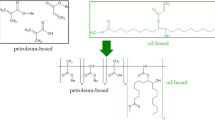Abstract
Novel crosslinked thin polymer networks based on vegetable oil hydroxy fatty acids (HFAs) were prepared by UV photopolymerization and their mechanical properties were evaluated. Two raw materials, castor oil and 7,10-dihydroxy-8(E)-octadecenoic acid (DOD) were used as sources of mono- and di-HFAs, respectively. Poly(ethylene glycol) (PEG) diacrylate and poly(ε-caprolactone) diacrylate were synthesized and used as crosslinking agents to form crosslinked polymer networks by UV-initiated free-radical polymerization with acrylated castor oil or acrylated DOD. The synthesis of acrylate derivatives was confirmed using FT-IR and 1H-NMR spectroscopic techniques. The composition of the reaction mixture and the type/length of crosslinking agent were changed to obtain crosslinked polymer networks with various mechanical properties. For polymers prepared from high molecular weight (20,000) PEG, a 58–60% of the initial weights decreased in 35 days in phosphate buffer solution (pH 7.2) containing lipase enzyme. These potentially biodegradable polymers based on vegetable oil HFAs can be used as eco-friendly materials for various applications to replace the existing petroleum-based polymers currently used.








Similar content being viewed by others
Abbreviations
- ACO:
-
Acrylated castor oil
- ADOD:
-
Acrylated 7,10-dihydroxy-8(E)-octadecenoic acid
- AESO:
-
Acrylated epoxidized soybean oil
- CO:
-
Castor oil
- DMPA:
-
2,2-Dimethoxy-2-phenylacetophenone
- DOD:
-
7,10-Dihydroxy-8(E)-octadecenoic acid
- HFA:
-
Hydroxyfatty acid
- PCLDA:
-
Poly(ε-caprolactone) diacrylate
- PEGDA:
-
Poly(ethylene glycol) diacrylate
- UV:
-
Ultraviolet
References
Zimmerman DC (1966) A new product of linoleic acid oxidation by a flaxseed enzyme. Biochem Biophys Res Commun 23:398–402
Chang I-A, Kim I-H, Kang S-C, Hou CT, Kim H-R (2007) Production of 7, 10-dihydroxy-8(E)-octadecenoic acid from triolein via lipase induction by Pseudomonas aeruginosa PR3. Appl Microbiol Biotechnol 74:301–306
Bae J-H, Suh M-J, Kim BS, Hou CT, Lee I-J, Kim I-H, Kim H-R (2010) Optimal production of 7,10-dihydroxy-8(E)-hexadecenoic acid from palmitoleic acid by Pseudomonas aeruginosa. New Biotechnol. doi:10.1016/j.nbt.2009.11.005
Hou CT, Forman RJ III (2000) Growth inhibition of plant pathogenic fungi by hydroxy fatty acids. J Ind Microbiol 24:275–276
Kato T, Yamaguchi Y, Abe N, Uyehara T, Nakai T, Yamanaka S, Harada N (1984) Unsaturated hydroxy fatty acids, the self-defensive substances in rice plant against blast disease. Chem Lett 25:409–412
Masui H, Kondo T, Kojima M (1989) An antifungal compound, 9, 12, 13-trihydroxy-(E)-octadecenoic acid, from Colocasia antiquorum inoculated with Ceratocytis fimbriata. Phytochemistry 28:2613–2615
Dumont M-J (2010) Polyurethanes plastic sheets and foams synthesized from aromatic triols. Ph.D. Dissertation, University of Alberta
Hou CT (2009) Biotechnology for fats and oils: new oxygenated fatty acids. New Biotechnol 26:2–10
Kim H-R, Gardner HW, Hou CT (2000) 10(S)-hydroxy-8(E)-octadecenoic acid, an intermediate in the conversion of oleic acid to 7, 10-dihydroxy-8(E)-octadecenoic acid. J Am Oil Chem Soc 77:95–99
Hou CT, Hosokawa M (2005) Production of value-added industrial products from vegetable oils: oxygenated fatty acids. In: Hou CT (ed) Handbook of industrial biocatalysis. CRC Press, Boca Raton, FL, USA, pp 7-1–7-25
Shogren RL, Petrovic Z, Liu Z, Erhan SZ (2004) Biodegradation behavior of some vegetable oil-based polymers. J Polym Environ 12:173–178
Petrovic ZS (2008) Polyurethanes from vegetable oils. Polym Rev 48:109–155
Campanella A, Bonnaillie LM, Wool RP (2009) Polyurethane foams from soyoil-based polyols. J Appl Polym Sci 112:2567–2578
Bonnaillie LM, Wool RP (2007) Thermosetting foam with a high bio-based content from acrylated epoxidized soybean oil and carbon dioxide. J Appl Polym Sci 105:1042–1052
Can E, Wool RP, Küsefoglu S (2006) Soybean and castor oil based monomers: synthesis and copolymerization with styrene. J Appl Polym Sci 102:2433–2447
Li F, Hasjim J, Larock RC (2003) Synthesis, structure, and thermophysical and mechanical properties of new polymers prepared by the cationic copolymerization of corn oil, styrene, and divinylbenzene. J Appl Polym Sci 90:1830–1838
Kim HM, Kim H-R, Kim BS (2010) Soybean oil-based photo-crosslinked polymer networks. J. Polym Environ. doi:10.1007/s10924-010-0174-3
Kim BS, Hrkach JS, Langer R (2000) Biodegradable photo-crosslinked poly(ether-ester) networks for lubricious coatings. Biomaterials 21:259–265
Lee K-S, Kim DS, Kim BS (2007) Biodegradable molecularly imprinted polymers based on poly(ε-caprolactone). Biotechnol Bioprocess Eng 12:152–156
Nelson JS, Applewhite TH (1966) Castor-based derivatives: synthesis of some acrylate esters. J Am Oil Chem Soc 43:542–545
Kim BS, Hrkach JS, Langer R (2000) Synthesis and characterization of novel degradable poly(ether-anhydride) networks. J Polym Sci Pt A Polym Chem 38:1277–1282
Kawai F (1994) Biodegradation of polyethers and polyacrylate. In: Doi Y, Fukuda K (ed) Biodegradable plastics and polymers. Elsevier, pp 24–38
Wu S, Rong M, Zhang M, Hu J (2007) Mechanical performance and biodegradability of the foams derived from soybean oil resin. Acta Polym Sin 10:993–998
Rong MZ, Zhang MQ, Wu SP, Wang HJ, Czigany T (2007) Ecomaterials-foam plastics synthesized from plant oil-based resins. Mat Sci Forum 539–543:2311–2316
Wang HJ, Rong MZ, Zhang MQ, Hu J, Chen HW, Czigany T (2008) Biodegradable foam plastics based on castor oil. Biomacromolecules 9:615–623
Acknowledgments
This work was supported by grant No. 2009-0083983 from the Basic Research Program of the National Research Foundation and by the Ministry of Knowledge Economy (MKE) and Korea Institute for Advancement in Technology (KIAT) through the Workforce Development Program in Strategic Technology.
Author information
Authors and Affiliations
Corresponding author
About this article
Cite this article
Kim, HM., Kim, HR., Hou, C.T. et al. Biodegradable Photo-Crosslinked Thin Polymer Networks Based on Vegetable Oil Hydroxy Fatty Acids. J Am Oil Chem Soc 87, 1451–1459 (2010). https://doi.org/10.1007/s11746-010-1634-6
Received:
Revised:
Accepted:
Published:
Issue Date:
DOI: https://doi.org/10.1007/s11746-010-1634-6




